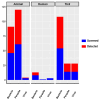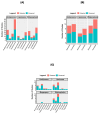Tick-Borne Diseases in Sub-Saharan Africa: A Systematic Review of Pathogens, Research Focus, and Implications for Public Health
- PMID: 39204297
- PMCID: PMC11356977
- DOI: 10.3390/pathogens13080697
Tick-Borne Diseases in Sub-Saharan Africa: A Systematic Review of Pathogens, Research Focus, and Implications for Public Health
Abstract
Sub-Saharan Africa, with its hot and humid climate, is a conducive zone for tick proliferation. These vectors pose a major challenge to both animal and human health in the region. However, despite the relevance of emerging diseases and evidence of tick-borne disease emergence, very few studies have been dedicated to investigating zoonotic pathogens transmitted by ticks in this area. To raise awareness of the risks of tick-borne zoonotic diseases in sub-Saharan Africa, and to define a direction for future research, this systematic review considers the trends of research on tick-borne bacteria, parasites, and viruses from 2012 to 2023, aiming to highlight the circulation of these pathogens in ticks, cattle, sheep, goats, and humans. For this purpose, three international databases were screened to select 159 papers fitting designed inclusion criteria and used for qualitative analyses. Analysis of these studies revealed a high diversity of tick-borne pathogens in sub-Saharan Africa, with a total of 37 bacterial species, 27 parasite species, and 14 viruses identified. Among these, 27% were zoonotic pathogens, yet only 11 studies investigated their presence in humans. Furthermore, there is growing interest in the investigation of bacteria and parasites in both ticks and ruminants. However, research into viruses is limited and has only received notable interest from 2021 onwards. While studies on the detection of bacteria, including those of medical interest, have focused on ticks, little consideration has been given to these vectors in studies of parasites circulation. Regarding the limited focus on zoonotic pathogens transmitted by ticks, particularly in humans, despite documented cases of emerging zoonoses and the notable 27% proportion reported, further efforts should be made to fill these gaps. Future studies should prioritize the investigation of zoonotic pathogens, especially viruses, which represent the primary emerging threats, by adopting a One Health approach. This will enhance the understanding of their circulation and impact on both human and animal health. In addition, more attention should be given to the risk factors/drivers associated to their emergence as well as the perception of the population at risk of infection from these zoonotic pathogens.
Keywords: pathogens; public health; research; sub-Sahara Africa; systematic review; tick-borne diseases.
Conflict of interest statement
The authors declare no conflicts of interest.
Figures










Similar articles
-
Current and future applications of species distribution and ecological niche modelling for the study of ticks and tick-borne pathogens.Med Vet Entomol. 2025 Sep;39(3):399-421. doi: 10.1111/mve.12820. Epub 2025 Jul 16. Med Vet Entomol. 2025. PMID: 40665816 Review.
-
Human pathogens associated with the blacklegged tick Ixodes scapularis: a systematic review.Parasit Vectors. 2016 May 5;9:265. doi: 10.1186/s13071-016-1529-y. Parasit Vectors. 2016. PMID: 27151067 Free PMC article.
-
Home treatment for mental health problems: a systematic review.Health Technol Assess. 2001;5(15):1-139. doi: 10.3310/hta5150. Health Technol Assess. 2001. PMID: 11532236
-
Major vectors and vector-borne diseases in small ruminants in Ethiopia: A systematic review.Acta Trop. 2017 Jun;170:95-104. doi: 10.1016/j.actatropica.2017.02.015. Epub 2017 Feb 14. Acta Trop. 2017. PMID: 28212848
-
Geographical distribution of ixodid ticks and tick-borne pathogens of domestic animals in Ethiopia: a systematic review.Parasit Vectors. 2022 Mar 28;15(1):108. doi: 10.1186/s13071-022-05221-x. Parasit Vectors. 2022. PMID: 35346354 Free PMC article.
Cited by
-
Bushmeat Consumption and the Risk of Zoonotic Tick-Borne Pathogen Infections in Ghana: An Increasing Risk to Public Health.Public Health Chall. 2025 Jul 30;4(3):e70096. doi: 10.1002/puh2.70096. eCollection 2025 Sep. Public Health Chall. 2025. PMID: 40741378 Free PMC article.
-
Tick-Borne Viruses in a Changing Climate: The Expanding Threat in Africa and Beyond.Microorganisms. 2025 Jun 28;13(7):1509. doi: 10.3390/microorganisms13071509. Microorganisms. 2025. PMID: 40732018 Free PMC article. Review.
-
Tick Diversity and Distribution of Pathogen in Ticks Collected from Wild Animals and Vegetation in Africa.Pathogens. 2025 Jan 25;14(2):116. doi: 10.3390/pathogens14020116. Pathogens. 2025. PMID: 40005493 Free PMC article. Review.
-
Seroepidemiology of Rickettsia conorii in dogs in Portugal: a comprehensive 12-year retrospective study (2013-2024).Parasit Vectors. 2025 Jun 23;18(1):238. doi: 10.1186/s13071-025-06859-z. Parasit Vectors. 2025. PMID: 40551164 Free PMC article.
References
-
- Muhammad A., Piyumali K.P., Abdullah I., Shumaila M. Ticks and Tick-Borne pathogens. Volume 9. IntechOpen.; London, UK: 2018. Ticks and Tick-Borne Pathogens; pp. 3–9.
Publication types
MeSH terms
Grants and funding
LinkOut - more resources
Full Text Sources
Medical

